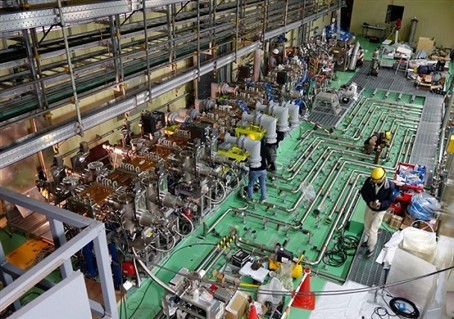Discover LIPAc-the accelerator that will bring us closer to fusion energy


The Broader Approach Agreement (BA) between Europe and Japan has created a successful collaborative framework in the field of fusion energy focusing mainly on those technological challenges beyond ITER. The BA projects bring together some hundreds of European experts from Belgium (SCK-CEN), France (CEA), Germany (KIT), Italy (ENEA, INFN and RFX), Spain (CIEMAT), co-ordinated by F4E and a comparable number of Japanese experts supervised by the Japanese National Institutes for Quantum and Radiological Science and Technology (QST). The nature of voluntary contribution underpinning the BA has fostered a collaborative spirit among the parties helping them to tackle successfully the “typical” difficulties associated with international Science and Technology partnerships such as project management, manufacturing, logistics, and communication.
LIPAc, the Linear IFMIF Prototype Accelerator, located at the International Fusion Energy Research Center is under assembly and commissioning at the BA site in Rokkasho. LIPAc is a prototype accelerator going through validation in order to be used in a future fusion neutron source, like IFMIF-DONES. The assembly of the equipment is now complete for its intermediate phase, where proton and deuteron beams of will be accelerated to 5 MeV in 2018, using a normal conducting accelerator element known as “RF Quadrupole”

For its final phase, expected to be concluded in March 2020, the ion beams will be accelerated to 9 MeV, installing in addition a superconducting accelerator element known as “SRF linac”. The needed cold temperatures are generated by a cryoplant which was commissioned and handed over to QST in September 2017.


The clock is ticking as the start of beam operation is scheduled for February 2018. This linear accelerator, small in size yet powerful, is expected to turn a new page for those working in the field of ion accelerators with major spin-offs for Accelerator Driven Systems (ADS) heading for waste treatment of fission power plant by transforming long lived radioisotopes or producing them for medical treatments.
During the recent BA Steering Committee held on 14 December in Mol (Belgium), the teams of IFMIF/EVEDA were congratulated for their work contributing to the concept of a fusion neutron source to be put into operation during the next decade; an essential step in the world fusion roadmap. The years ahead promise to be exciting with LIPAc providing breakthroughs in accelerators technologies by operating both proton and deuteron beams in unprecedented conditions.
The Project Leader, Juan Knaster, affirms that “leading IFMIF/EVEDA these last five years has been a unique experience. We have demonstrated how organisational and technical difficulties in an international context can be overcome fostering communication and mutual trust among stakeholders. In-kind projects are inherently difficult but the F4E-QST partnership has proven to be so successful that it has generated spin-offs in the European-Japanese technological collaborations. In addition, the on-going success of LIPAc is having a positive impact on the credibility of the fusion programme since we are achieving unprecedented operational conditions in accelerators technologies.”